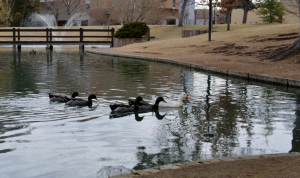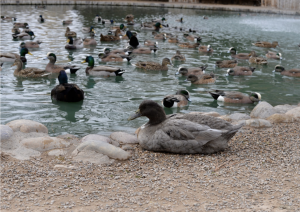By Madison Spratto / New Mexico News Port
As part of our Curious UNM project, our reporters are seeking questions about the University of New Mexico. These questions can look at any aspect of life on campus, from historical moments to current events. This story looks at the question, “How is the Duck Pond Maintained?”
The University of New Mexico’s Duck Pond is more than a peaceful place to relax between classes; it’s also an entire ecosystem for the animals that live there.
Kevin O’Hair, UNM’s attending veterinarian, helps care for the wildlife at the pond.
O’Hair said one of the biggest problems is people bringing and releasing their aquatic pets.
“Several of the animals found that have been released are not native species and some introduced have diseases that compromise the health of pond residents,” he said. “This occurred a few years ago with a sudden illness in several old turtles that were infected with a stomach nematode parasite that was likely introduced by pet turtles.”
O’Hair said the foreign intruders include ducks, fish and even the occasional red eared sliders. They coexist with native turtles that include softshell, snapping and pond turtles.
During the bi-annual draining of the pond, O’Hair monitors the procedures and ensures animals are safe and treated humanely.

Steve Howe, the public information officer for UNM Facilities Management, said the cleaning—which is scheduled this March during Spring Break—includes draining the water and clearing out debris. During this process, some 30 members of the grounds and landscaping staff capture the domestic ducks for temporary relocation. Meanwhile, the wild ducks that call the pond home find somewhere else to go.
The other wildlife stay closer to home. After fish and turtles are safely captured, they are put into holding tanks outside Castetter Hall to be monitored and cared for.
The next cleaning also includes the pond’s animal census.
Howe said the last official count in 2018 found 84 turtles, 76 bass, 56 large koi, 16 small koi, nine carp and a single catfish.
In the past there have been unexpected items found during the draining process, such as bicycle seats, a laptop and a few cell phones.
Facility Management isn’t alone in their efforts. Howe said, in the past, members of the biology department have participated in the clean up and care of the animals.
“We hope to work with them again, though we are in the early stages of making the arrangements for this year’s cleaning and are not yet able to confirm who will participate,” he said.
O’Hair said it is difficult to keep track of how many ducks are utilizing the pond because of the numerous domestic ducks that often flock to other places, and migration brings more animals.

The pond itself is home to Wood Ducks, Mallard Ducks, Ospreys and wintering American Wigeon, O’Hair said. He estimates there are around 100 species of birds that can be identified throughout the year, making the Duck Pond a prime spot for birding. He said during the spring and fall migrant birds will frequent the flowing stream and surrounding trees.
The grounds and landscaping division is also responsible for the general upkeep of the Duck Pond. This entails day-to-day maintenance such as ensuring the fountains are working, and cleaning up trash and debris.
Although feeding the animals may seem like a harmless pastime, Howe said it’s dangerous for the animals and the condition of the water. He said the ecosystem of the pond provides them with all the nutrients they need.
As for the future of the pond, O’Hair said minor improvements are in the works, including adding more nesting sites for waterfowl and sunning spots for turtles. There are also long-term goals to improve habitats by offering hides, nests and perches.
Aesthetically, UNM officials are working to improve the pond by making a softer marshy edge, adding a new pond liner and a new water-circulation system to improve the water quality. O’Hair said they also want to enhance the public’s access and scenery with new landscaping while not sacrificing the habitats.
“There are many students and others from the public that enjoy and learn about nature at (the Duck Pond),” O’Hair said. “I hope we can make it a better place for public viewing and interaction, and improve the habitat for numerous species that reside or stop in during migrations”
Gabriella Valdez, a biology major, said she visits the pond occasionally and would do more homework there soon, suggesting that tables would make it a more desirable spot to work or eat.
“I enjoy the animals and the sound of the water,” she said. “I love the turtles.”
Madison Spratto is a reporter for the New Mexico News Port. She can be contacted on Twitter @Madi_Spratto or at nmnewsport@gmail.com.